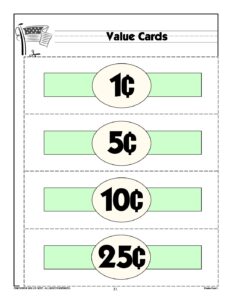Summary
Students will play a game in which they determine the number of cents (pennies) that equal a nickel, dime, and quarter. The students will also identify which set of coins has more, fewer, or the same amount while also counting each collection and writing the corresponding value.
Objectives
- Students will play a game in which they determine the number of cents (pennies) that equal a nickel, dime, and quarter.
- The students will also identify which set of coins has more, fewer, or the same amount while also counting each collection and writing the corresponding value.
Subject Area
- Math
Grades
- K
Class Time
- Total Time: 0-45 Minutes minutes
Materials
- The "What's The Value?" worksheet
- The "How Many Make a…?" worksheet
- Colored pencils and/or crayons
- One of each coin: cent, nickel, dime, and quarter
- Images of coins from the U.S. Mint Image Library (link: https://www.usmint.gov/news/image-library/circulating)
- Glue
- Scissors
- Value card sets
Background Knowledge
Students should have basic knowledge of:
- The cent sign (¢)
- Counting by fives and tens
- Coins and the value of a cent, nickel, dime, and quarter
Lesson Steps
- To review the value of a cent, nickel, dime and quarter as a class, play the following game with your students.
- Give each student a set of value cards. Tell them to lay out each card in front of them.
- Hold up one of the four coins for all students to see. Or display an image of a coin from the U.S. Mint image library. Ask students to select a value card and hold it up to show the number of cents that the coin is worth.
- Ask the students how many cents this coin is worth. Solicit group response.
- Show the students the correct value (selected from the teacher's set of value cards).
- Ask students if that coin's value is greater than, less than, or equal to a different coin that you select.
- Repeat numerous times, randomly selecting one of the four coins. (As a challenge, display all four coins in a random order. Have the students place the corresponding value cards in that same order.)
- Introduce the "How Many Make a …?" worksheet. Review the directions with the class and ask students to complete this worksheet individually. When students finish, check worksheets for understanding.
- Work with students to complete the "What's the Value?" worksheet. This can be completed as a class or in small groups with or without supervision as necessary.
Differentiated Learning Options
- Use coins or other manipulatives to complete "What's the Value?" questions.
- Compare coin amounts in terms of "more than," "less than," or "equal to."
- Hold up a value card and invite students to find different combinations of coins that equal the amount on the value card.
- Have students use dice and change (cents, nickels, dimes, and quarters) to play a game in pairs. For each roll, the student will get that number of cents. Students will trade up for coins of greater value, and the first to reach a quarter wins.
Assess
Use the game to assess whether the students have met the lesson objectives.
Common Core Standards
Discipline: Math
Domain: K.MD Measurement and Data
Grade(s): Grade K
Cluster: Describe several measurable attributes of a single object
Standards:
- K.MD.2. Directly compare two objects with a measurable attribute in common, to see which object has "more of"/"less of" the attribute, and describe the difference. For example, directly compare the heights of two children and describe one child as taller/shorter.
- K.MD.3. Classify objects into given categories; count the numbers of objects in each category and sort the categories by count.
National Standards
Discipline: Mathematics
Domain: All Problem Solving
Cluster: Instructional programs from kindergarten through grade 12 should enable all students to
Grade(s): Grades K–12
Standards:
Discipline: Mathematics Domain: K-2 Number and Operations Cluster: Compute fluently and make reasonable estimates. Grade(s): Grades K–12 Standards: In K through grade 2 all students should
Discipline: Mathematics Domain: All Communication Cluster: Instructional programs from kindergarten through grade 12 should enable all students to Grade(s): Grades K–12 Standards:
- Build new mathematical knowledge through problem solving
- Solve problems that arise in mathematics and in other contexts
- Apply and adapt a variety of appropriate strategies to solve problems
- Monitor and reflect on the process of mathematical problem solving
Discipline: Mathematics Domain: K-2 Number and Operations Cluster: Compute fluently and make reasonable estimates. Grade(s): Grades K–12 Standards: In K through grade 2 all students should
- develop and use strategies for whole-number computations, with a focus on addition and subtraction;
- develop fluency with basic number combinations for addition and subtraction; and
- use a variety of methods and tools to compute, including objects, mental computation, estimation, paper and pencil, and calculators.
Discipline: Mathematics Domain: All Communication Cluster: Instructional programs from kindergarten through grade 12 should enable all students to Grade(s): Grades K–12 Standards:
- organize and consolidate their mathematical thinking through communication
- communicate their mathematical thinking coherently and clearly to peers, teachers, and others;
- analyze and evaluate the mathematical thinking and strategies of others; and
- use the language of mathematics to express mathematical ideas precisely.
Subscribe to our
Lessons that Make Cents newsletter.

